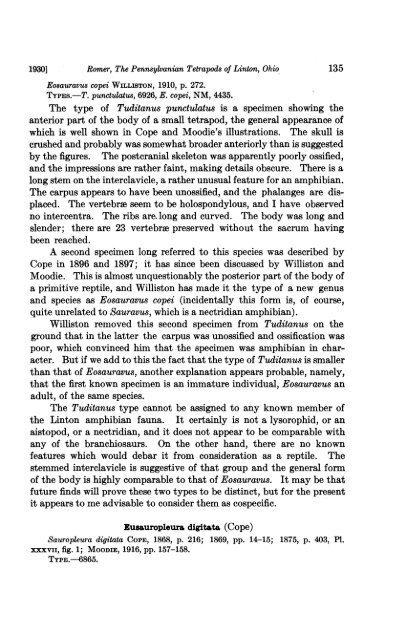View/Open - American Museum of Natural History
View/Open - American Museum of Natural History
View/Open - American Museum of Natural History
You also want an ePaper? Increase the reach of your titles
YUMPU automatically turns print PDFs into web optimized ePapers that Google loves.
1930]<br />
Romer, The Pennmylvanian Tetrapods <strong>of</strong> Linton, Ohio135<br />
Eosauravus copei WILLISTON, 1910, p. 272.<br />
TYPES.-T. punctulatus, 6926, E. copei, NM, 4435.<br />
The type <strong>of</strong> Tuditanus punctulatus is a specimen showing the<br />
anterior part <strong>of</strong> the body <strong>of</strong> a small tetrapod, the general appearance <strong>of</strong><br />
which is well shown in Cope and Moodie's illustrations. The skull is<br />
crushed and probably was somewhat broader anteriorly than is suggested<br />
by the figures. The postcranial skeleton was apparently poorly ossified,<br />
and the impressions are rather faint, making details obscure. There is a<br />
long stem on the interclavicle, a rather unusual feature for an amphibian.<br />
The carpus appears to have been unossified, and the phalanges are displaced.<br />
The vertebrae seem to be holospondylous, and I have observed<br />
no intercentra. The ribs are. long and curved. The body was long and<br />
slender; there are 23 vertebrae preserved without the sacrum having<br />
been reached.<br />
A second specimen long referred to this species was described by<br />
Cope in 1896 and 1897; it has since been discussed by Williston and<br />
Moodie. This is almost unquestionably the posterior part <strong>of</strong> the body <strong>of</strong><br />
a primitive reptile, and Williston has made it the type <strong>of</strong> a new genus<br />
and species as Eosauravus copei (incidentally this form is, <strong>of</strong> course,<br />
quite unrelated to Sauravus, which is a nectridian amphibian).<br />
Williston removed this second specimen from Tuditanus on the<br />
ground that in the latter the carpus was unossified and ossification was<br />
poor, which convinced him that the specimen was amphibian in character.<br />
But if we add to this the fact that the type <strong>of</strong> Tuditanus is smaller<br />
than that <strong>of</strong> Eosauravus, another explanation appears probable, namely,<br />
that the first known specimen is an immature individual, Eosauravus an<br />
adult, <strong>of</strong> the same species.<br />
The Tuditanus type cannot be assigned to any known member <strong>of</strong><br />
the Linton amphibian fauna. It certainly is not a lysorophid, or an<br />
aistopod, or a nectridian, and it does not appear to be comparable with<br />
any <strong>of</strong> the branchiosaurs. On the other hand, there are no known<br />
features which would debar it from consideration as a reptile. The<br />
stemmed interclavicle is suggestive <strong>of</strong> that group and the general form<br />
<strong>of</strong> the body is highly comparable to that <strong>of</strong> Eosauravus. It may be that<br />
future finds will prove these two types to be distinct, but for the present<br />
it appears to me advisable to consider them as cospecific.<br />
Eusauropleura digitata (Cope)<br />
Sauropleura digitata COPE, 1868, p. 216; 1869, pp. 14-15; 1875, p. 403, P1.<br />
xxxvii, fig. 1; MOODIE, 1916, pp. 157-158.<br />
TYPE.-6865.
















